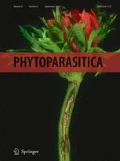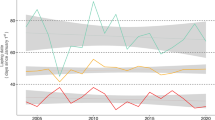Abstract
Overwintering biology of Orius vicinus (Ribaut) (Hemiptera: Anthocoridae) was investigated between November 2017 and April 2018 in the Balcalı location of Adana Province, Turkey under outdoor conditions. The duration of egg and nymphal development time, pre-oviposition, oviposition and post-oviposition periods of females, the number of eggs laid and adults longevity were determined by the experiments performed in the first day of each experimental month under the outdoor conditions at the Department of Plant Protection, Faculty of Agriculture, University of Çukurova. The duration of egg hatching lasted between 5 and 10 days in all months of experiment and the tested eggs were hatched even at low temperature and under short day length conditions. More than half of the nymphs obtained from the tested eggs became adults in the winter months. Despite the nymph’s survival was affected negatively by the sudden changes in temperature, they were tolerant to the low temperatures and short-day lengths during the winter period. All females in the trials oviposited for about 30 days even in the coldest periods (approximately 15 °C). The females were not affected by the environmental conditions particularly in winter season, and they did not undergo reproductive diapause. The obtained data shed light on the overwintering biology of O. vicinus which may be helpful for their potential role in controlling the non-diapaused pest species such as pest thrips in the early spring season.

Similar content being viewed by others
References
Akramovskaya, E. G. (1978). The biology of some bugs of the family Anthocoridae in conditions of the Ararat valley in Armenia. Biologicheskii Zhurnal Armenii, 31(9), 959–964.
Alauzet, C., Dargagnon, D., & Malausa, J. C. (1994). Bionomics of a polyphagous predator: Orius laevigatus (Het.: Anthocoridae). Entomophaga, 39(1), 33–40.
Atakan, E. (2010). Influence of weedy field margins on abundance patterns of the predatory bugs Orius spp. and their prey, the western flower thrips (Frankliniella occidentalis), on faba bean. Phytoparasitica, 38, 313–325.
Bahşi, ŞU., & Tunç, I. (2008). Development, survival and reproduction of Orius niger (Hemiptera: Anthocoridae) under different photoperiod and temperature regimes. Biocontrol Science and Technology, 18(8), 767–778.
Ballal, C. R., & Yamada, K. (2016). Anthocorid predator. In Omkar (Ed.), Ecofriendly pest management for food security. London: Elsevier.
Barzman, M., Bàrberi, P., Birch, A. N. E., Boonekamp, P., Dachbrodt-Saaydeh, S., Graf, B., et al. (2015). Eight principles of integrated pest management. Agronomy for Sustainable Development, 35(4), 1199–1215.
Carvalho, A. R., Bueno, V. H. P., Pedroso, E. C., Kon, L. I., Diniz, A. J. F., & Silva, R. J. (2006). Influence of photoperiod on Orius thyestes Herring (Hemiptera: Anthocoridae) reproduction and longevity. Neotropical Entomology, 35(4), 489–492.
Chyzik, R., Klein, M., & Ben-Dov, Y. (1995). Overwintering biology of the predatory bug Orius albidipennis (Hemiptera: Anthocoridae) in Israel. Biocontrol Science and Technology, 5(3), 287–296.
Cocuzza, G. E., De Clercq, P., Van De Veire, M., De Cock, A., Degheele, D., & Vacante, V. (1997). Reproduction of Orius laevigatus and Orius albidipennis on pollen and Ephestia kuehniella eggs. Entomologia Experimentalis et Applicata, 82(1), 101–104.
Danks, H. V. (1987). Insect dormancy: an ecological perspective. Ottawa: Biological Survey of Canada (Terrestrial Artropods).
DeBach, P. (1964). Biological control of insect pests and weeds. New York: Reihold.
Duso, C. (1989). Role of the predatory mites Amblyseius aberrans (Oud.), Typhlodromus pyri Scheuten and Amblyseius andersoni (Chant) (Acari, Phytoseiidae) in vineyards. Journal of Applied Entomology, 107(1–5), 474–492.
Fernandez-Cornejo, J., Nehring, R. F., Osteen, C., Wechsler, S., Martin, A., & Vialou, A. (2014). Pesticide use in US agriculture: 21 selected crops, 1960–2008. Washington, DC: U.S. Department of Agriculture, Economic Research Service.
Heitmans, W. R. B., Overmeer, W. P. J., & Van Der Geest, L. P. S. (1986). The role of Orius vicinus Ribaut (Heteroptera; Anthocoridae) as a predator of phytophagous and predacious mites in a Dutch orchard. Journal of Applied Entomology, 102(1-5), 391–402.
Howarth, F. G. (1991). Environmental impacts of classical biological control. Annual Review of Entomology, 36(1), 485–509.
IBM Corp. Released (2017). IBM SPSS Statistics for Windows, Version 25.0. Armonk: IBM Corp.
Kirk, W. D. J., & Terry, L. I. (2003). The spread of the western flower thrips Frankliniella occidentalis (Pergande). Agricultural and Forest Entomology, 5(4), 301–310.
Larivière, M. C., & Wearing, C. H. (1994). Orius vicinus (Ribaut) (Heteroptera: Anthocoridae), a predator of orchard pests new to New Zealand. New Zealand Entomologist, 17(1), 17–21.
Lattin, J. D. (1999). Bionomics of the Anthocoridae. Annual Review of Entomology, 44, 207–231.
Meehan, T. D., Werling, B. P., Landis, D. A., & Gratton, C. (2011). Agricultural landscape simplification and insecticide use in the Midwestern United States. Proceedings of the National Academy of Sciences, 108(28), 11500–11505.
Musolin, D., Tsytsulina, K., & Ito, K. (2004). Photoperiodic and temperature control of reproductive diapause induction in the predatory bug Orius strigicollis (Heteroptera: Anthocoridae) and its implications for biological control. Biological Control, 31, 91–98.
Pehlivan, S. (2019). Predatory Orius (Hemi̇ptera: Anthocoridae) species in Adana provi̇nce, their population fluctations with thrips (Thysanoptera) species on summer vegetables, and some biological characteristics of Orius vicinus (Ri̇baut) at laboratory conditions. Dissertation, University of Çukurova.
Pehlivan, S., Alınç, T., & Atakan, E. (2017). Avcı böcekler Orius niger Wolff ve Orius vicinus (Ribaut) (Hemiptera: Anthocoridae)’un bazı biyolojik özelliklerinin araştırılması. Türkiye Biyolojik Mücadele Dergisi, 8(1), 49–58.
Pehlivan, S., & Atakan, E. (2017). Some biological parameters of Orius niger (Wolff, 1811) (Hemiptera: Anthocoridae) under outdoor conditions in Turkey. Turkish Journal of Entomology, 41(2), 231–231.
Pehlivan, S., & Atakan, E. (2020). Distribution and seasonal abundance of predatory bugs, Orius spp. (Hemiptera: Anthocoridae) in Adana province, Turkey. Turkiye Entomoloji Dergisi, 44(1), 57–69.
Péricart, J. (1972). Hémiptères: Anthocoridae, Cimicidae et Microphysidae del’Ouest Paleartique. Paris: Masson et C.ie ed.
Saulich, A. Kh., & Musolin, D. L. (2009). Seasonal development and ecology of anthocorids (Heteroptera: Anthocoridae). Entomology Review, 89, 501–528.
Tauber, M. J., Tauber, C. A., & Masaki, S. (1986). Seasonal adaptations of insects. Oxford: Oxford University Press on Demand.
Tommasini, M. G. (2004). Collection of Orius species in Italy. Bulletin of Insectology, 57, 65–72.
Tommasini, M. G., & van Lenteren, J. C. (2003). Occurrence of diapause in Orius laevigatus. Bulletin of Insectology, 56(2), 225–251.
Van Den Meiracker, R. A. F. (1994). Induction and termination of diapause in Orius predatory bugs. Entomologia Experimentalis et Applicata, 73(2), 127–137.
van Lenteren, J. C. (2012). The state of commercial augmentative biological control: plenty of natural enemies, but a frustrating lack of uptake. BioControl, 57, 1–20.
Wearing, C. H., & Attfield, B. (2002). Phenology of the predatory bugs Orius vicinus (Heteroptera: Anthocoridae) and Sejanus albisignata (Heteroptera: Miridae) in Otago, New Zealand, apple orchards. Biocontrol Science and Technology, 12(4), 481–492.
Wearing, C. H., & Colhoun, K. (1999). Development of Orius vicinus (Ribaut) (Heteroptera: Anthocoridae) on different prey. Biocontrol Science and Technology, 9(3), 327–334.
Wright, B. (1994). Know your friends: minute pirate bugs. Resource document. Midwest Biological Control News Online. http://www.entomology.wisc.edu/mbcn/kyf101.html. Accessed 25 Aug 2020.
Acknowledgements
The authors thank to Dr. Tange Denis Achiri from the University of Çukurova for reading and editing the manuscript.
Author information
Authors and Affiliations
Corresponding author
Ethics declarations
Conflict of interest
Authors have no conflict of interest to declare.
Additional information
Publisher’s note
Springer Nature remains neutral with regard to jurisdictional claims in published maps and institutional affiliations.
Rights and permissions
About this article
Cite this article
Alınç, T., Atakan, E. & Pehlivan, S. Overwintering biology of the predatory bug, Orius vicinus (ribaut) (Hemiptera: Anthocoridae) under outdoor conditions in the eastern mediterranean region of Turkey. Phytoparasitica 49, 579–587 (2021). https://doi.org/10.1007/s12600-021-00889-w
Received:
Accepted:
Published:
Issue Date:
DOI: https://doi.org/10.1007/s12600-021-00889-w




